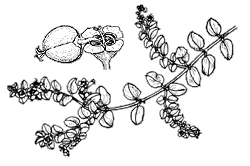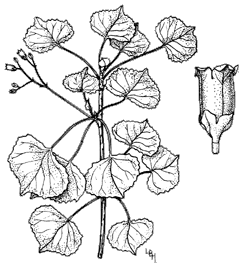Euphorbiaceae (spurge family)
The 8000 worldwide species of spurges are as ecologically diverse as the composites. They occupy most habitats and exhibit nearly every growth form used by plants. In fact, annuals, perennials, trees, succulents, C3, C4, and cam species can all be found in the single genus Euphorbia. Until recently this genus contained the little weedy spurges in our gardens, the spectacular Christmas poinsettia (which originated in tropical Mexico), and African succulents—some of which are nearly perfect mimics of the New World cacti. Now some taxonomists raise many of our species previously in a subgenus Chamaesyce to the genus Chamaesyce.
 |
Recognizing such a diverse family by vegetative characteristics is virtually impossible. In most species the inflorescence is a cyathium, a single female flower with its distinctive 3-lobed ovary surrounded by a number of male flowers consisting of a single stamen each. The male cyathia may have colorful bracts that resemble petals (e.g., crown of thorns—Euphorbia milii), and some species have colored leaves that serve the same function (e.g., poinsettia, Euphorbia pulcherrima). In some species male and female flowers are borne on separate plants. A few genera produce more typical flowers with true sepals and petals. The poinsettia is one of the largest ornamental nursery crops; tens of millions are produced annually for the Christmas season. Other economically important examples include manihot (the source of cassava and tapioca) and castor bean (the source of the once-popular health remedy, castor oil).
Jatropha cardiophylla
English names: limberbush, dragon’s blood (both applied to several
other species)
Spanish names: sangregado, sangrengado (contractions for dragon’s blood), torote, sangre de cristo (de drago) (Christ’s or dragon’s blood)
Description
Limberbush is a shrubby succulent to 3 feet (1 m) tall consisting of many usually unbranched stems arising from fleshy underground rhizomes. The branches are semisucculent and extremely pliable, and have smooth reddish bark. Bright green, heart-shaped leaves are present only during the brief summer rainy season. The flowers are tiny whitish bells that appear during the rainy season. (This genus has “normal” flowers with petals.)
 |
Range
South-central Arizona and most of Sonora below 4000 feet (1200 m) elevation.
Notes
This is the northernmost North American Jatropha, a worldwide genus of 170 mostly frost-sensitive tropical species. The above-ground stems are succulent, but much of its biomass is in the massive underground roots, which can produce new stems quickly after being killed to the ground by periodic severe freezes. Coral bean (Erythrina flabelliformis) has a similar growth form in the north end of its range where it is occasionally killed to the ground by both frost and fires. Limberbush shares with ocotillo the trait of having both long shoots that produce stems, and short shoots at each original long-shoot leaf; the latter produce leaves periodically without sprouting new branches. The pollinator is a rare tiny fly.
Limberbush heralds the arrival of the summer monsoon. The increased humidity associated with this seasonal wind shift induces leaf production within a week or so. The leaves remain small until the first rain provides the moisture for their full expansion. The leaves turn yellow and fall soon after the air dries out at the end of the monsoon.
The O’odham use limberbush extensively in basketry. It is a widespread toothache treatment.
Jatropha cuneata grows in the driest of desert subdivisions. Its many stems arise from a very short trunk.










